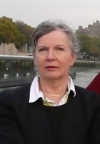Mary Eagle

Mary Eagle is an art historian, with additional experience as an art critic and art curator. She is former Head of Australian Art at the National Gallery of Australia, is a Harold White fellow at the National Library of Australia, and is currently writing about the life and work of the Anglo-American artist Augustus Earle (1793–1838).
Lawrence Alloway observed that Abstract Expressionism was the creation of middle-aged artists and not an avant-garde. Jackson Pollock was in his mid-thirties and already a considerable painter when he laid a canvas on the floor and began to swing paint on a stick. Willem de Kooning and Barnett Newman were in their forties before they found their signature styles. For twenty years, those painters e ... (read more)
A book of letters between ‘Bert’ and ‘Ned’ resonates nicely with the famous letters of Smike to Bulldog, published in 1946, the year young Albert Tucker completed his first images of Modern Evil, and Sidney Nolan began his first Ned Kelly paintings. The fascination of this correspondence, between artists destined to be as famous for their period as Arthur Streeton and Tom Roberts for ... (read more)
In the 1990s the Smithsonian Institution conducted a comprehensive survey of visitors to exhibitions in the United States and concluded that the majority of viewers, while retaining impressions of individual objects, are unlikely to take much note of an exhibition’s theme. That came as a surprise to art gallery and museum professionals, who had recently put much effort into didactic displays, wi ... (read more)
Gary Catalano’s book, which I admire greatly, is a readjustment. His standpoint, so far as I can tell, is an ideal he has of what might be the suitable creative situation for artists, and he reviews the 1960s with this in mind.
Instead of seeing the development towards abstraction as inevitable or even the main issue of 1960s art, he finds the major break in the later 1960s when Australian art ... (read more)
In Brenda Niall’s biography of Judy Cassab, the art forms of the subject and the author – life story and portraiture – are nested one in the other. As the story builds, one comes to accept that certain unsparing reflections on the subject’s personality and behaviour have as their authority Judy Cassab herself. She emerges as a heroine in a decidedly modern mode.
Reproduced in this biograp ... (read more)
Janine Burke’s Australian Women Artists, 1840–1940 is a memento of the exhibition of women’s art initiated by the Ewing Gallery for 1975, International Women’s Year. An extraordinarily rich exhibition, it convinced me and many others who saw it on its tour of the eastern states, that Australian women painters, for at least the first 30 years of this century, must share the laurels equally ... (read more)
John McPhee put John Glover in the picture, identifying him as the foreground figure with sketchbook sharing our view of the Tamar River at Launceston. David Hansen saw that Glover marked his Hobart Town house in special colour at the centre of a distant panorama of the town, the viewpoint for which is across the Derwent in a sportive scene of Indigenous Tasmanians at Kangaroo Point. For that work ... (read more)
Behind Philip Jones’s Ochre and Rust: Artefacts and encounters on Australian frontiers are many books about the interaction of settlers and indigenes. Writers relevant to this book include the museum curator Aldo Massola (writing in the 1960s and 1970s) and retired archaeologist John Mulvaney (writing in the 1980s and 1990s). Massola brought out objects and archival material from the Museum of V ... (read more)
One of the characters in Stephen Spender’s novel The Temple, written in the early 1930s, is a young German photographer. They met in Hamburg in 1929. Spender, a university student just discovering the autobiographical bent of his own inspiration, observed that his friend’s attitude was very different. Instead of wanting to preserve the sensuality of the moment in monumental form, the German ph ... (read more)
